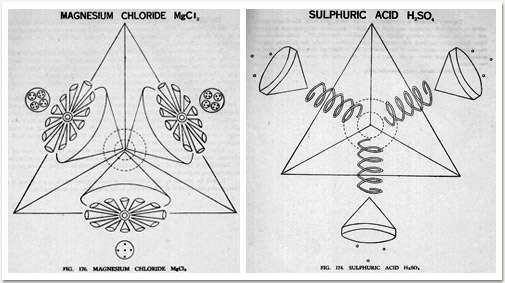In 6th century BCE the concept that matter is composed of discrete and not infinitely reducible units developed in India. Around 460 B.C. the Greek Democritus named these fundamental and irreducible bits of matter átomos, meaning “uncuttable.” Notions of this kind were at this point in history, more than anything, matters of pure Philosophy. As such, when the big daddy Aristotle weighed in and rejected the idea as worthless, “the atom” was pretty much stopped in its tracks. It would be a couple thousand years before Science picked up where Philosophy had left off. But before Science made its first excited indirect observations of electrons and protons and managed to put forward a widely acceptable model for the structure of the atom, another group stepped forward to ply their trade in the service of atomic knowledge. They were theosophists, known collectively as the Occult Chemists, and their goal was nothing less than “direct observation of atoms through clairvoyance.”
Contact (i)
Search (i)
Annex (i)
Special Projects (i)
Downloads (i)
Shop (i)
Archives (i)
Links (i)
Feeds: rss2 | atom (i)

Occult Chemistry


The Recumbent Supper
If I accosted you on the street, grabbed you by the shoulders, and blurted, “The Last Supper!” involuntarily (and to spite your fear of being pawed and shouted at by a lunatic) an image would form in your head. We all know what that image is without any need of my describing it because its roughly the same image we all conjure up. It would seem that Western depictions of the last supper, most notably Leonardo Da Vinci’s incredibly iconic version, have dominated the popular imagination in regard to this biblical event to such a degree that we’ve been left with an unshakeable mental image. As it happens, however, it’s an image which deviates considerably not only from scriptural description but from historical reality.
In his 1980 book Now I Lay Me Down to Eat, Notes and Footnotes on the Lost Art of Living writer, architect, collector, teacher, designer, and social historian Bernard Rudofsky used this misconception as a jumping off point to examine western attitudes toward everything from eating to sleeping to sitting to bathing to crapping. It’s a terrific book which, like many of his books, served as an accompaniment to a museum exhibition exploring the same subjects.
In any case, sticking with the Last Supper, I wanted to share a few paragraphs by Rudolfsky on the subject as it’s an interesting historical wrinkle which I suspect many remain unaware of.
-
“One would think that a people that swears by the Bible would be at least vaguely familiar with some of tlie customs of biblical times. Alas, we are not; devout and impious alike are uninformed about testamentary etiquette. What, for instance, do we know about the seating and eating ceremonial at the Last Supper? No more, to be sure, than the fifty-odd generations of artists who, unacquainted as they were witli ancient usages, concurred in misrepresenting the momentous event. Thanks to them, the picture we have formed of it is a glaring anachronism—the apostles might as well be wearing black tie. The legions of painters and carvers were forever at a loss to interpret such stage directions as Saint John ‘lying close to the breast of Jesus’ (John, 13:23). All their attempts to follow the Scriptures to the letter— that is, to portray a recumbent John among companions stiff as pokers—presented an unsolvable problem. Whatever the extenuating circumstances, their common expedient to depict John napping is nothing short of slander.

A trifling incident in our eyes, it does, however, illustrate our ignorance and ensuing intolerance of all conduct that deviates from our own, and this furnishes the keynote to our musings. If Jesus Christ should want to visit this country, he certainly would have to mend his ways. A repetition of the multiplication of bread might be greeted with hosannas, but a miracle of changing water into wine would land him in jail in the holier of our states. Clearly, we’ve gotten the better of scriptural ethics.
To our way of thinking, lying down to a meal connotes debauch. Yet that was the way to eat in Christ’s time among middle- and upper-class Romans and Jews, just as it was for centuries before and after. A corroboration comes from instructions for Passover service: ‘On drinking the four cups, one leans to the left side, as it was the custom in ancient times among free noblemen wlio used to dine on couches in a leaning position.’ Although endorsed in religious doctrine, such behavior seems absurd to us; the whole concept of palpable conviviality flies in the face of our presumed respectability. And yet, wise men with a flair for good living have been known to disregard popular prejudice. ‘I like to eat and drink in a recumbent position (preferably on a couch)’ wrote Nabokov.
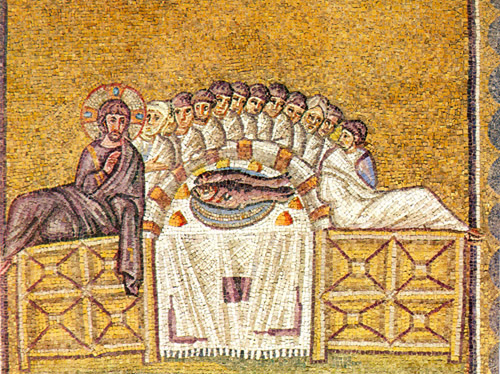
The mosaic (above) shows the recumbent figures on a sigma—a crescent-shaped couch—which, together with the table, forms one single piece. The apostles fit into each other as neatly as stacking chairs—a tangible expression of conviviality. Following the custom of the time, Christ, the host, occupies the place of honor, at the extreme left.
Little of this fraternal closed circuit remains in the Westernized Last Supper. Body contact has given way to discreet stand-offishness; invisible place cards have spread a chill through the proceedings. So has the inexorable grip of symmetry. Christ has been assigned a place in the center and, following Western protocol, everybody is sitting upright, except Saint John, who snuggles up to the Savior s bosom. Such seeming lack of self-control calls for closer inspection.
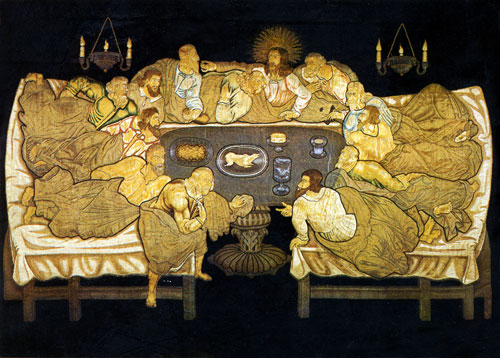
Christian iconography reveals a surprisingly rich repertory of John’s labored poses. He nestles his head in Christ’s palm or in the crook of His arm; hides behind His back; leans on His shoulder; or, most unceremoniously, rests his head right on the table; while Christ, to all appearances, remains oblivious of his beloved disciples difficulties. A New Testament Rip van Winkle, John failed to make the transition from past to present, from East to West. He alone remained faithful to his forefathers’ habits, which his companions, finding them out of place, preferred to ignore. They are portrayed either occupying benches or stools or simply sitting on the floor. A few artists who knew better put them on couches; yet, right down to our time—and this ought to set us thinking—not one presented them sitting on chairs. They all seem to have been aware that there was something very wrong with the looks of a chair.” -Bernard Rudofsky, Now I Lay Me Down To Eat, 1980.
-
Now granted, for many of us the first thought might be something along the lines of, “well, does the historical accuracy of paintings depicting fictional events matter much?” To which I’d have to agree, no, not really. But it’s still interesting.
Hope you enjoyed.
hide full text

On The Magic Island
By W.B. Seabrook with illustrations by Alexander King.
In 1929 a travelogue was released that would, through the chain reaction it set off, have a profound effect on American popular culture and by extension the American collective consciousness. It was written by a fellow with a questionable resume of personal traits said to include alcoholism, occultism, sensory deprivation, and sadism, who would ultimately commit suicide by pill-overdose. His is not a household name, and is rarely spoken, yet it is through the continued fascinated invocation of another name altogether that we unknowingly evoke his legacy: Zombie! Zombie!! Zombie!!!
He was William Buehler Seabrook, a reporter and Lost Generation writer (claiming the minor distinction of having written the first celebrity rehab tell-all) and it was his book, The Magic Island, a sensationalized account of his voodoo-mad travels throughout Haiti, that first ushered our beloved un-dead bugaboo, the zombie, onto American shores.
Though The Magic Island did
notrepresent the first usage in English print of the word zombie (it appeared as a term connected to a Voodoo snake god much earlier) as the author later claimed in his autobiography, Seabrook’s book was the first popular English language text to confront the phenomena of the Haitian “living dead” head-on. The book referred to these shambling, dead-eyed, unfortunates as “Zombies” + and they have moved, at varying speeds, among us ever since.
The popularity of his book, with its sensational but not altogether unsympathetic characterizations, dovetailed perfectly with a zeitgeist that would also yield the nearly concurrent release of Hollywood’s iconic monster features. The result of which was an immediate pop-cultural embrace, bringing this new terror into our stable of more veteran ghouls like Dracula and Frankenstein without so much as a second interview. Seabrook’s book was all it took.
The giddy excitement entertainers felt at having a new abomination to play with resulted, almost immediately, in a broadway play—Kenneth Webb’s 1932 flop Zombie—and a film—the infamous 1932 indie, and granddaddy of all zombie flicks, White Zombie—not to mention multiple lawsuits. A scant 3 years after America first saw the word in print courts were obliged to rule “zombies” as being in the public domain. And are they ever. After 1932 it is a truly rare thing for a year to pass by completely undisturbed by the walking dead.
Zombie! Zombie!! Zombie!!!
Though it is most notable for this popularization The Magic Island, a 336p book, in actuality only devoted 12 scant pages, a single chapter titled “...Dead Men Working in the Cane Fields” to le culte des morts’ handiwork. The rest of the book is full of sensational tales of ritual, magic, sacrifice, potions, feverish midnight sex-dances, and all of the objective reportage one might expect from an alcoholic, occult-dabbling, middle-aged white man traveling through Haiti in the 1920’s.
I picked up a first edition copy a few weeks back, just out of curiosity, and was thrilled to find that not only is it a pretty fascinating read, biases and euphemistic “of it’s time” pronouncements aside, but that their were pictures! Joy! The book contains about 30 photographs taken by Seabrook during his travels, but more interestingly a large group of original illustrations by a one Alexander King.
A search for more info on Mr. King does not offer much.
AskArt offers us this: “Described as a thief, morphine addict, failing playwright and painter, Alexander King was a man of iconoclastic observations and caustic humor who began his career as a painter of human figures, focused primarily on the face. Then he became an art thief, stealing fifty prints from the Metropolitan Museum. He was jailed twice, and married four times.”
While the IMDb says only: “Alexander King, by his own admission, had a very checkered career before becoming racontuer on residence during the Jack Parr years of “The Tonight Show”. A veteran newspaperman turned press agent, he published his various anecdotes in a series of off-beat books that were very popular at the time. Nearly forgotten today, King, who claimed to have been married five times, was a fixture on the TV talk show circuit from roughly the mid-1950s until his death in 1965.”
Various searches do reveal, without a doubt, that he illustrated many books throughout the 30’s and 40’s however, and with the pedigree outlined above, he was a perfect match for Seabrook and his Magic Island.
Below I’ve reproduced 9 of King’s illustrations from The magic Island including, for a few, some corresponding text by Seabrook. Have a look…
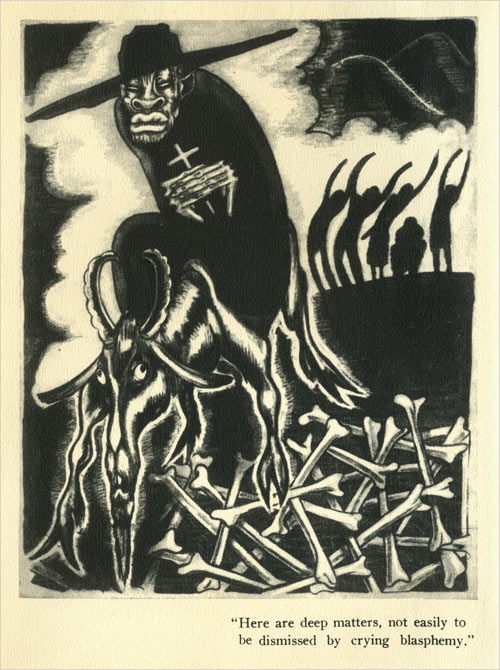

Quote: “Louis, son of Catherine Ozias of Orblanche, paternity unknown—and thus without a surname was he inscribed in the Haitian civil register—reminded me always of that proverb out of hell in which Blake said, “He whose face gives no light shall never become a star.” It was not because Louis’ black face, frequently perspiring, shone like patent leather; it glowed also with a mystic light that was not always heavenly. For Louis belonged to the chimeric company of saints, monsters, poets, and divine idiots. He used to get besotted drunk in a corner, and then would hold long converse with seraphim and demons, also from time to time with his dead grandmother who had been a sorceress.”

Quote: “The celebrants approached, processionally, singing, from the mystery house. At the head came the papaloi, an old man, blue-overalled, bare-footed, but with a surplice over his shoulders and a red turban on his head, waving before him the açon, a gourd-rattle wound round with snake-vertebrae. At his right and left, keeping pace with him, two young women held aloft, crossed above his head, two flags on which were serpentine and cabalistic symbols, sewn on with metallic, glittering beads. Behind him marched a young man bearing aloft, horizontally on his upstretched palms, a sword, and next the mamaloi, a woman in a scarlet robe and feathered headdress, who revolved as she progressed in a sort of dervish dance; next came marching, two and two, a chorus of twenty or more women robed in white, with white cloths wound bandana-wise on their heads, and as they slowly marched they chanted:
Damballa Oueddo,
Nous p’ vim
It would be best translated, I think, Oh, Serpent God, we come.”

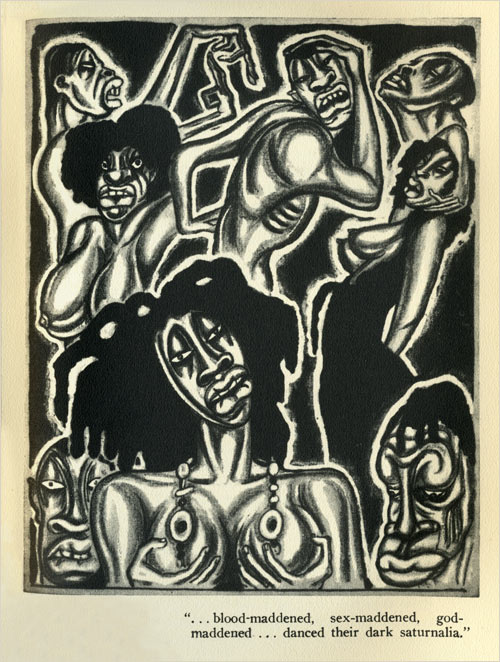
Quote: “In the red light of torches which made the moon turn pale, leaping, screaming, writhing black bodies, blood-maddened, sex-maddened, god-maddened, drunken, whirled and danced their dark saturnalia, heads thrown weirdly back as if their necks were broken, white teeth and eyeballs gleaming, while couples seizing one another from time to time fled from the circle, as if pursued by furies, into the forest to share and slake their ecstasy.”

Quote: “One of the most dreaded forms of Haitian-African magic includes the dressing of a corpse in a garment of the person marked for vengeance and then exposing it to rot away in some secret place in the jungle. Men have gone stark mad seeking that jungle-hidden horror, and others have died hopelessly, searching. Fear, hunger, thirst, jungle-terror, one may say. Names again, tags, labels. But marked for death by the Voodoo curse, they died.”

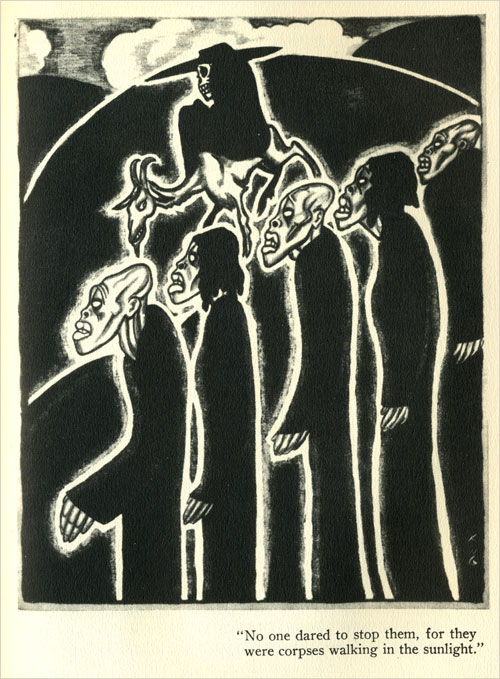
Quote: “It seemed that while the zombie came from the grave, it was neither a ghost, nor yet a person who had been raised like Lazarus from the dead. The zombie, they say, is a soulless human corpse, still dead, but taken from the grave and endowed by sorcery with a mechanical semblance of life—it is a dead body which is made to walk and act and move as if it were alive. People who have the power to do this go to a fresh grave, dig up the body before it has had time to rot, galvanize it into movement, and then make of it a servant or slave, occasionally for the commission of some crime, more often simply as a drudge around the habitation or the farm, setting it dull heavy tasks, and beating it like a dumb beast if it slackens.”
So while this text offers the first English language popularization of the word “zombie” those last 3 Illustrations, interestingly, represent the first images anyone associated the word. All in all fascinating bit of pop-cultural, if not exactly ethnographic or anthropological, history.
Jay A. Graybeal says in his terrific summation of Seabrook’s story: “Big lusty, restless, red-haired William Buehler Seabrook spent more than 20 years seeking fantastic adventure, then putting what he found into books which thrilled some, shocked many. But he never will write the story of his greatest adventure. Secretly and alone he embarked upon it not long ago by way of an overdose of sedative. The coroner says Bill Seabrook committed suicide. But his friends have a different explanation for what happened. They say he only was making another more drastic attempt to accomplish what he had tried, vainly, all his life to do—to get away from himself.”
Alester Crowley, an acquaintance of Seabrook’s, put it rather more bluntly in a diary entry: “The swine-dog W. B. Seabrook has killed himself at last.”
In 1966, a year after his death, a critic writing a review for a Seabrook biography said: “his principal literary contribution, it would seem, is the word zombie.” That may in fact be the truth. But how very impressive, built as it was on 12 short pages of reportage, that contribution turned out to be.
Zombie! Zombie!! Zombie!!!
Hope you enjoyed.
-
Related Linkage:
The Roots of the Modern Zombie Movie
Zombies in Popular Culture
Scifipedia: Zombies
The History of Zombies
Zombies in Early Horror Films
Voodoos and Obeahs
Gothic capitalism: The Horror of Accumulation and the Commodification of Humanity.
Black Religion and Black Magic: Prejudice and Projection in Images of African-derived Religions


Perverse, Subversive, and Absurd
Or: The Poster Art of Tomi Ungerer.
Tomi Ungerer’s work, along with that of a handful of others, might rightly be considered to not only embody the design style of the 60’s and 70’s, but to have played a central part in that style’s ascendence. Throughout those decades Mr. Ungerer’s work was everywhere, encompassing everything from politics and commercial concerns to erotic publications and children’s books. He was prolific, and in no realm more so than in that of the poster.
As it happens just yesterday I came across the perfect resource to illustrate that point, the 1971 book The Poster Art of Tomi Ungerer, compiled and edited by Jack Rennert. Below I’ve reproduced, for your viewing pleasure and Mr. Ungerer’s glorification, a small sampling of the terrific poster work contained therein. Have a look…


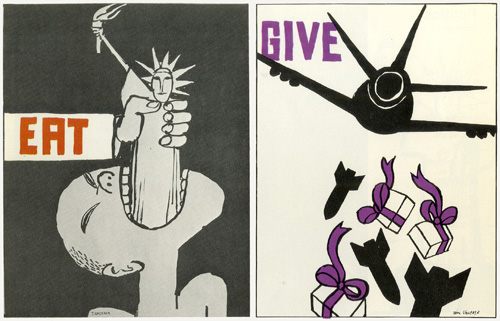


Quote: “Expect the unexpected” is a fitting description of all of Tomi’s posters. The element of surprise, the element of the absurd, is a clear constant in his posters. When Tomi is finished with a poster design, he will step back a bit, and if he’s really satisfied with what he’s done, he’ll say, “It’s absurd!”
This very absurdity, achieved by elements of surprise and exaggeration, makes for a good poster: one of the key elements of a good poster is that it be arresting, that it be immediately compelling. This propensity for gleefully combining the improbable with the absurd is carried through in all of Tomi’s works.” -Jack Rennert.
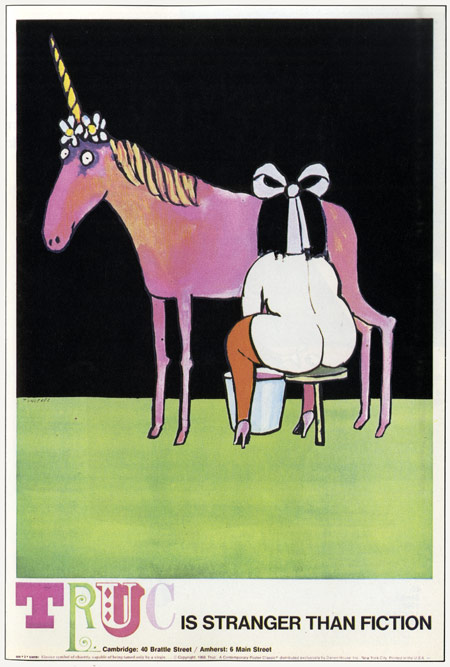
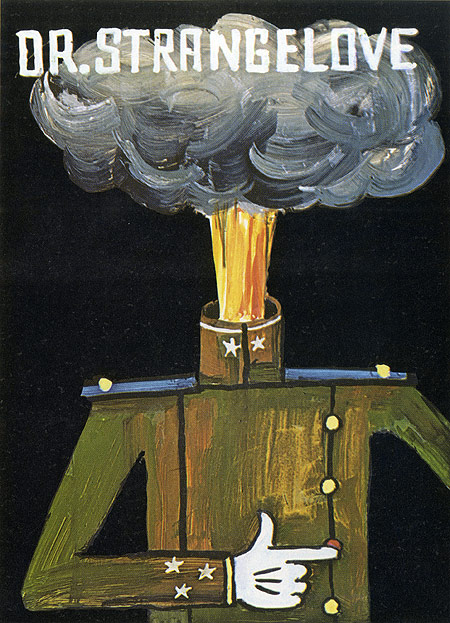




Quote: “Hans Pflug, writing about Tomi’s work when he first came to the United States, noted: ‘His drawings and advertisements all give the impression of having occurred to him in a flash, and of having been captured on paper with equal immediacy.’ To watch Tomi at work is to know that this was an accurate observation and is still so. What is amazing to me, is that Tomi at once gets a complete image of what he wants to do, and putting it down on paper becomes almost the automatic reflex of his clearly ‘seen’ image. He rarely goes back over his lines. They are immediately, cleanly, and finally, put down on paper. He may not be satisfied when he’s finished and will throw the whole thing out, but he’ll seldom redo or rework his lines or colors.” -Jack Rennert.





Quote: “The main influences in my work were, as a child, Mathias Grunewald, Durer, Schongauer, as well as Hansi and Schnugg, both Alsatian illustrators. Later came Goya, Bosch, the Japanese graphists (Hokusai, etc.), the old issues of Simplicissimus, and Wilhelm Busch.
My high school records were crowned with the final remark: ‘Perverse and subversive.’
My interest and hobbies vary and alternate: flying kites and balloons, old toys, books, bondage, erotica, minerology, botany, medicine, jazz-the list is vain and endless. My most meaningful author is Louis Ferdinand Celine, my favorite painter is Ingres, and Bach’s is just about the only music that gives me total satisfaction.” -Tomi Ungerer, from the introduction to The Poster Art of Toimi Ungerer





It was no easy task choosing what to include here but I hope you enjoyed these.
You can visit Tomi Ungerer’s homepage if you’d like to see some more of his work.
Also I’ve posted a small set of pieces Mr. Ungerer created for a 1966 IBM exhibition called Some Computer ABC’s over at the Nonist Annex.
Lastly, in that I was unable to find anything comparable on the web—the horse’s mouth and all that—I wanted to offer the full text of the biographical sketch Mr. Ungerer wrote for the introduction to the book. You can read it here.
hide full text

Subjectivity and the Subjugated
Feathers and beak but not a bird, not quite. It is roughly man-shaped; and though the head tilts and the arms outstretch like a midnight stranger, without a face and without hands it is not a man either, not quite. It is Man-but-not-Man, that most ancient mold for the manufacture of disquiet, never failing to lend a nightmarish quality to the unknown. The light is cluttered with hard shadows and the mind, unsure, is forced toward interpretation. You are a child and it is a swooping, enveloping horror. You are a hunter and it’s an avenger. You are a Freudian and it is your mother hovering, unreachable, in the middle-distance. You are a seer and it is an omen. You are a vaudevillian and it is a punch-line delivered into silence. You are a captain of industry and it is an accusatory night-sweat. On and on for each. At bottom its simple: you are a you and it is not, which is enough. Its “otherness” provokes an aggressive subjectivity.
The figure in the image is actually a Kwakiutl tribesman dressed as a Thunderbird. It’s a detail of a photograph shot by Edward S. Curtis, published in 1914. If you’ve never heard of Curtis he was a portrait photographer, living in Seattle, who decided sometime around 1900 to begin documenting the Native American tribes living in the Pacific Northwest. This project, with eventual interest of Theodore Roosevelt and resultant funding by J.P. Morgan, evolved into a 20 volume ethnographic opus called The North American Indian. The first volume was published in 1907, the last in 1930, at which point Curtis had shot about 45,000 photographs of over 80 separate tribes. Impressive though those numbers are, and expansive though the project was ⊕ Curtis died in 1952, broke, and with his life’s work forgotten.
“They cannot represent themselves, they must be represented.” So said Karl Marx. Were that representation pictorial and cultural rather than political, the sentiment might well be characterized as the driving force behind The North American Indian project. Curtis was a strong adherent to the prevailing sense that the American Indian was a “vanishing race” with no hope of maintaining any identity as Indian, and that it was the duty of the dominant culture to record the existence of the one being absorbed.
It was this conviction that lead him, in the course of his documentations, to go so far as to stage photographs depicting tribal traditions which had gone out of popular practice 50 years prior to his arrival with camera in hand. He paid tribes to undertake ceremonies out of season and reestablish ceremonies no longer practiced. He brought with him props, wigs, shirts, and other accouterments to “reenact” scenes, and was careful to remove “modern” items already adopted by tribes from the frame before shooting. His interest was in the “traditional” Indian, regardless of whether those traditions had already evolved away from the preconceptions of white america.
It’s because of this subjective tampering that Curtis’ photographs, even after their rediscovery and popularization in the 1970’s, remain somewhat controversial. On the one hand there are charges that his photographs, to large degree, simply reenforced the condescending stereotype of the “noble savage.” On the other hand it is unarguable that much of the material in The North American Indian does, in fact, represent unique ethnographic data recorded nowhere else. The prevailing attitude toward the project seems to be that though it is most assuredly “of its time,” harboring all manner of preconception, it is none the less invaluable for what it did manage to record.
In any case as regards Curtis’ life work I think it’s important to mention two things:
1) Even without intervention or the use of props or staging, photographs of this kind, framing a conquered culture through the conqueror’s lens and produced specifically for the conqueror’s consumption, will inherently deal in presuppositions. That seems inescapable. They will reinforce stereotypes to the exact degree to which the viewer, or framer, holds them dear.
2) Regardless of exactly the nature of what his photographs evoke, they are evocative, and very often beautiful, which is possibly the best one can say about a photograph from the artist’s standpoint. Not from a documentarian’s, or an ethnologist’s standpoint certainly, but from an artist’s.
Now to the photographs themselves…
Let me be the first to admit that when you have a collection as large as Curtis’ to draw from, you can gather together a group of pieces that illustrate damn-near any point of view you wish to support. For my part, I don’t want to drive home any particular point about Curtis’ outlook or the experience of the Native American’s he photographed.
I chose 18 images, drawn mainly from his time spent with the Kwakiutl and Navajo tribes, and exclusively of men obscured by ceremonial dress, their humanity left only as a vague outline, because I find them to be, as a group, a particularly potent illustration of the subjectivity inherent to viewing not only photographs of other cultures, images of the “Other,” and images of the unknown, but images of the past in general. These photographs are of men without men’s faces, without eyes to search, without familiar situations to read into, and so you are left to your own perceptual devices.


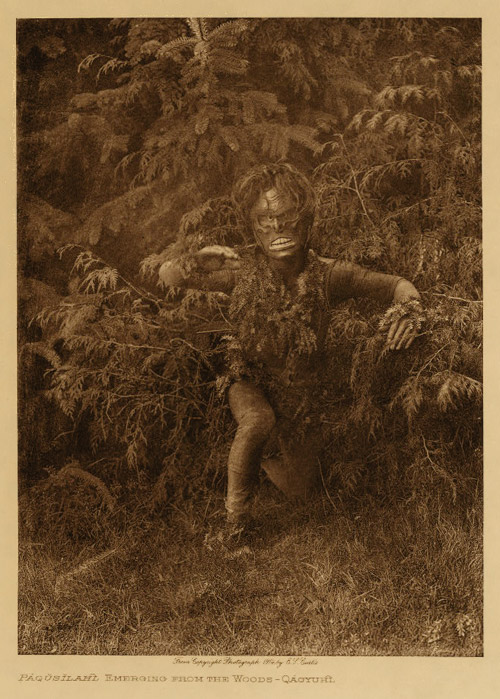


Quote: “It is a truism that to visitors of a new land – certainly to settlers – the original inhabitants were profoundly Other: The settlers may have had to struggle physically with the indigenous people for possession of the land, and in the process the original inhabitants became that which the settlers defined themselves against. It was virtually inevitable that the representations… would incorporate, reflect, or respond to, perhaps justify, the assumptions of the dominant (whites). ...The representations produced by the project tend to conform, in other words, to the lineaments of “the white man’s Indian.” ...Members of a dominant group, no matter how “intimate” their sense of their involvement with the people concerned, will represent nothing but the assumptions of their own kind.” – From the introduction to Edward S. Curtis and the North American Indian by Mick Gidley.
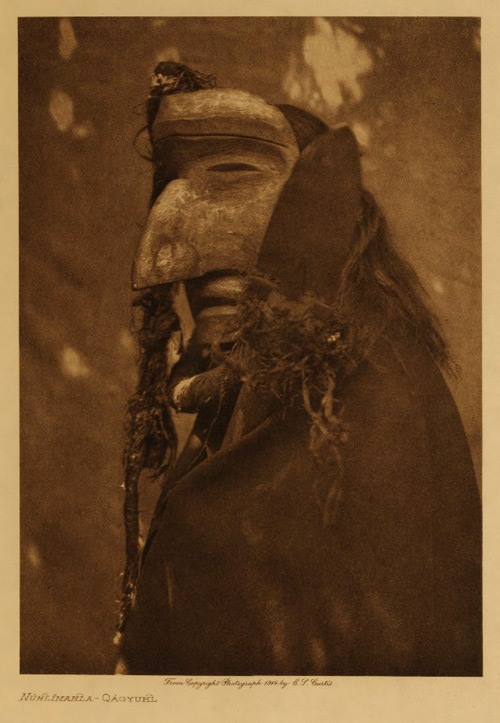



Quote: “If the modes of seeing in different communities are at least in some respect irreconcilable because they reflect incommensurable presuppositions about the human situation, how can such communities understand one another? Or are cultures windowless monads– communally solipsistic entities in which only those who share the same conventions can make sense of one another, with everything outside the cultures walls either ignored or relegated to the status of error? Can one culture use its own terms to say something about another culture without engaging in a hostile act of appropriation or simply reflecting itself and not encountering the otherness of the Other? –From Chapter 2 of Play and the Politics of Reading: The Social Uses of the Modernist Form by Paul B. Armstrong.

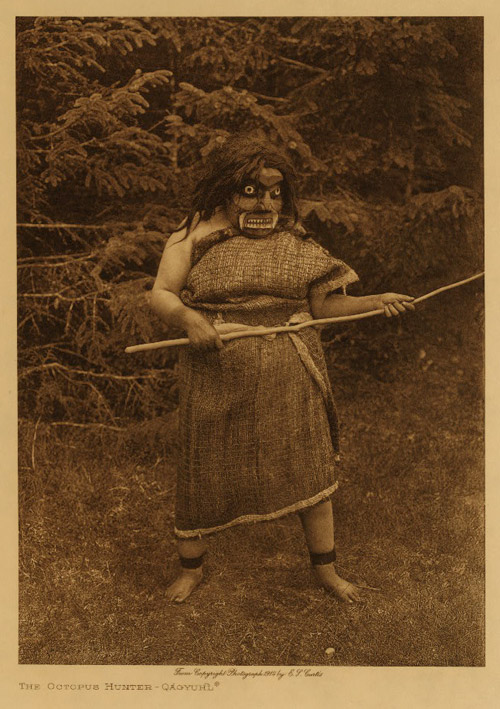



Quote: “When the last Red Men shall have perished, and the memory of my tribe shall have become a myth among the white man, these shores will swarm with the invisible dead of my tribe, and when your children’s children think themselves alone in the field, the store, the shop, or in the silence of the pathless woods, they will not be alone.” -Attributed to Cheif Seath in an address surrendering the Puget Sound region to Governor Isaac Stevens in 1854, but which is almost certainly a fanciful recreation set down by some unknown author many years later. Coincidentally, it was Seath’s daughter, Princess Angeline, who was Curtis’ first Native American subject.




Personally I find this group of photos, in the almost total disembodiment of their actual subjects, really compelling. Their historical accuracy makes no difference. I can’t help but imbue them with a host of disparate, sometimes totally contrary emotions. My mind draws all kinds of corollaries and branches out into all kinds of narratives. Most likely you, yourself, draw a whole other set of conclusions…
Anyhow, though Curtis didn’t live to see it, his work is now widely written about and very well represented on the internet. Curtis’ story is a fairly interesting one, the debate over and reactions to his work even more so, and there is a whole lot of it to be seen out there if your so inclined-
Nortwestern University Collection
Library of Congress Collection
Old-picture.com collection
First People
Project Gutenberg
Edward S. Curtis in Context
Selling the North American Indian
Flurry & Company Ltd.
Video excerpts from Coming To Light
PBS American Masters
Prayer to the Great Mystery
The Imperfect Eye of Edward Curtis.
Etc, Etc, Etc.
Hope you enjoyed.
hide full text

And the Hippos Were Boiled in Their Tanks
Being dead has got to be a drag. Being dead and famous? Still a drag, but at least you impressed yourself into the wax of the world sufficiently to live on, if only in name, for a while longer. Being dead and a famous artist? That’s a whole other tank of hippos. It would seem if you achieve fame in your lifetime as an artist your fate after death is to have every awkward, stinking, aborted creative-effort dragged from the darkness of its banishment, tagged, and shoved under the bright lights. That thing you made whilst naked in the mountains, blindfolded, heartbroken, raving, high on poisonous toad-skin, which you set down in grasshopper blood on the back of a banana leaf… that thing which you awoke three days later to find wedged between a wet deer skull and your car’s front tire… if you were too weak to burn it then when you had the chance, that thing will be found and packaged, and your name will be emblazoned across it, and it will be sold. Yes indeed. It will be sold to someone, or anyone, or everyone with a jangling pile of coins burning a hole in their pocket.
News was just recently released that Penguin will be publishing a novel co-authored by Jack Kerouac and William Burroughs which was written in 1945, before either achieved fame, or, one might argue, before either achieved talent. Not that this is necessarily a case such as that sketched in my over-dramatic first paragraph, but I can say with something approaching certainty that there is a reason why artists decline to put particular works out there.
Is this one a festering pustule on the golden, glorified legacies of two beat luminaries? I have no idea. Burroughs himself dismissed it as “not a very distinguished work.” ⊕ So the question begs to be asked, though we hail famous artists as “geniuses,” and fawn over their pronouncements, and make pilgrimages to their grave sites, and gobble critical texts parsing their brilliance, does it just so happen that the one area in which they are totally deficient is judging the merits of their own work?
The title of this “undistinguished” novel is evidently something Burroughs heard on a newscast about a zoo fire: And the Hippos Were Boiled in Their Tanks. I actually love the title, though perhaps And the Artists Were Exploited in Their Caskets would be closer to the bone.

The events which inspired And the Hippos Were Boiled in Their Tanks certainly sound novel-worthy, complete with obsession, drunken knife-fights, murder, body dumping, and the incarceration of our intrepid beat luminaries. Surely its publication will have some redeeming value? Whether just for historians and completists and rubber-neckers, or as a work in and of itself, is yet to be seen.
I have to wonder what the artists themselves would think were they alive? Would they be embarrassed? Displeased? Would the fact that even their “undistinguished” works made it to a clamoring marketplace simply satisfy their egos and overrule their internal editors? Would they grin from their easy chairs unable to beat back the maniacal words, “I am legend”?
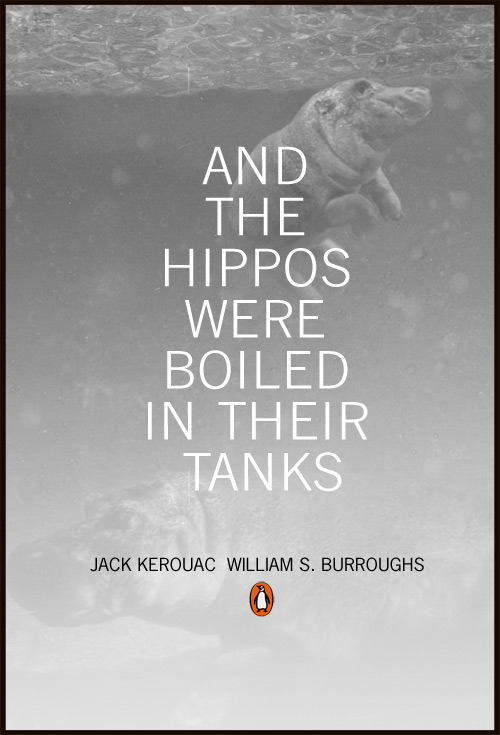
Letting “unsuccessful” works linger in drawers and boxes under beds is a weakness for most artists I’d say, but then, when they are your creations, even abortive ones, abhorrent ones, embarrassing ones, and your intention is to mournfully review them every decade or so as you would review old correspondences or family photographs, they retain a definite personal value. A personal value.
After Henry Miller’s death Moloch and Crazy Cock came to light, neither of which were sterling examples of his incredible talent ⊕, likewise Bukowski has had damn near as many books of poetry published since his death as before. At what point does the pile of “not ready for prime time” work of an artist begin to tarnish his or her legacy? Does it ever? Is our insatiable desire to know everything about those we’ve immortalized self-defeating? And are we actually entitled to see the things artists didn’t want to have seen? It may well be that we afford our idols more “personal space” physically, after their deaths, than we do metaphorically.
It’s a moot point I guess. There’s money to be made and industry marches on. ⊕ And perhaps, just perhaps, the rationalization that even a turd from a master is better than nothing is true. One thing we can be sure of is that neither Jack, nor William, nor Henry, Nor Buk give a good god-damn either way right now, and we can take heart in the fact that while they lived, their art was their own.
hide full text

A Little Girl Dreams Of Taking The Veil
Before the combination of Photoshop and, this vast repository of source-materials, the internet began spawning what now certainly amount to billions of wry photo-mashups, there was a predecessor which required of its practitioners expert hand-skills and vision and resourcefulness. I’m talking, of course, about collage, and in the days before pixels, indeed before periodicals positively overflowed with photographic imagery, a fellow, without formal training, by the name of Max Ernst took the form to places previously unimagined.
Around 1919, after having studied philosophy at the University of Bonn and serving in the German army on both the Western and Eastern fronts, Ernst began experimenting with collage. He explains the impetus as follows:
“One day (in 1919), whereas I looked at an illustrated book of objects (umbrellas, watches, tools, clothing, etc) I was surprised to see such different things tight beside the others, things which one does not see together usually, my eyes saw other objects, I wanted to add with the pencil some lines and hatchings between the various objects so that it gives the same images that I see in my dreams.” –Max Ernst.
“It was enough at that time to embellish these catalogue pages, in painting or drawing, and thereby in gently reproducing only that which saw itself in me, a colour, a pencil mark, a landscape foreign to the represented objects, the desert, a tempest, a geological cross-section, a floor, a single straight line signifying the horizon ... thus I obtained a faithful fixed image of my hallucination and transformed into revealing dramas my most secret desires—from what had been before only some banal pages of advertising.” —Max Ernst: Beyond Painting 1948.
The collage-novels which Ernst began creating in 1929, including La Femme 100 têtes (The Hundred Headless Women) and Une Semaine de bonté (A Week of Kindness), undoubtedly represent a pinnacle of the form.
I’d like to share with you some examples from a third collage novel by Ernst, published in 1930, titled, Rêve d’une petite fille qui voulut entrer au Carmel or, A Little Girl Dreams of Taking the Veil, which I am lucky enough to own a copy of. It is the story of a girl who loses her viginity on the day of her first communion and so commits herself to “taking the veil.” The collages, each accompanied by a few short lines, are visualizations of the impious, schizophrenic, and mostly nightmarish dreams she has that night.
The book begins with a 5 page surrealistic sketch by way of introduction. Here is an excerpt:
Academy of Science.
The night will come when the Academy of Science itself will not disdain to cast its gaze on the sewers of the world. The night will come when, covered with all their jewels, the secondary skeletons that one calls scientists will ask themselves this question:
?What do little girls dream of who want to take the veil?
?On that night a violent storm will break against the doors of the academy of science and the water will roar in the pipes.
?The water will remember the shameful year 1930, the year it would have liked to see all the cathedrals of the universe parade in far-too-short dresses. It will remember above all a certain night because…
?On Good Friday night of the shameful year 1930 a child hardly sixteen years old dipperd her two hands in the sewer, pricked her skin and with her blood traced these lines”
?To love the holy father and to dip one’s hands in a sewer, such is happiness for us, children of Mary.
77 collages follow, separated into four sections. Below I’ve reproduced 15 of them complete with accompanying text. Have a look.















The book’s translator’s note has this to say on the collages themselves:
“Each one of these collages uses cuttings often from the most banal of pre-photography illustrated penny novels, and from popular tomes about nature, science, and exoticism. The result may seem to embody our most frequent tragedies, our wriest enslavements, our most terrible solutions. Specificity dissolves in the timeless and the general.” —Dorothea Tanning.
The introduction to Max Ernst: A Retrospective adds the following:
“Max Ernst’s collages, for all their strangeness, strive for overall coherence and technical plausibility. This ‘plausible’ imagery, unlike the papiers colles of Picasso and Georges Braque, depends on an expurgation of the visible difference between artist’s hand and non-artistic quotation. The joins and overlappings had to be concealed from the viewer. This is why Ernst frequently published his composite imagery only in printed form, in photographic reproduction or in versions later touched up with watercolour. Thanks to these tactics of concealment he succeeded in presenting collage as that which he thought it should be: a completely developed and autonomous system in which the origin of the separate elements is submerged in the final, total image. He was out to produce irritating imagery in which, as in the perfect crime, every clue to its identity had been erased.” — Werner Spies.
To me there is a gravitas to etchings and wood engravings, a sort of official-ness, which is unshakeable. Perhaps it is simply the obvious effort involved in their creation or their historic connection with inherently valuable printed matter (be it newspaper or book) which lends the form these overtones. In any case, I think it is exactly this implied gravitas playing against Ernst’s strange, poetic, feverish, and funny subject matter, which creates the oddly arresting magnetism they still manage to exert almost 80 years later. I can only wonder at the effect they had on viewers in the 30’s… Some mixture of giggle and shiver I would imagine.
Anyhow, hope you enjoyed these.
For more on Ernst’s collage-novels see:
Une Semaine de Bonté: A Surrealistic Novel in Collage on google books.
Une Semaine de Bonté at La Boîte A Images.
A Week of Kindness at Giornale Nuovo.
La femme 100 têtes at Koninklijke Bibliotheek.
Werner Spies’ piece at Artchive.com.
The enduring significance of the work of Max Ernst By Stuart Nolan.
Max Ernst’s Adventures in Collage from The New York Times.
Kindness Week a film by Ernst based on his collage.
Ernst related videos at Tiosam.com
-
Note: This post is in a series of reworkings of old posts which date from before the redesign of The Nonist. The text has been reworked and added to considerably, the amount of images has been doubled, and the links are all new. I will be periodically adding these reworkings into the flow of new content in an effort to eventually remove all the old pages from circulation.
hide full text

Histoire Naturelle des Indes
The Histoire Naturelle des Indes, created sometime in the 1590’s, is one of the earliest illustrated records of European contact with the America. Also know it by its informal title The Drake Manuscript it was donated to the the Pierpont Morgan Library in 1983, who after many years of study graciously produced a full color facsimile. I happen to have said facsimile, which was published in 1996, right here in front of me. Shall we take a gander?
First a few words on the manuscript’s origins and possibly misleading title.
The Drake Manuscript is named for Sir Francis Drake, the famed English privateer, navigator, slave trader, politician, and pirate of the Elizabethan era, whose travels it is thought to illustrate. Though Drake was himself something of an artist ⊕, the images in Histoire Naturelle des Indes were not created by his hand. Nothing of his artwork survives as it turns out.
Truth be told there is no conclusive evidence to suggest that Drake had anything to do with the manuscript, let alone that it ought to be informally named after him. Such are the gears of history- grinding the anonymous down to invisibility and raising the famed higher… for a while at least.
The best guess as to the manuscripts origins are something along these lines-
The naive drawings ⊕ show signs of being created by several separate hands. Context reveals that these were likely the hands of Huguenots. Drake is known to have employed not only Huguenots on his voyages but artists as well. A “considerable number” of the images correspond to ports of call familiar to Drake, in some cases associated directly with his voyages, and Drake is mentioned by name, twice, in the manuscript itself. Hence, with a nice pile of circumstantial evidence to stand on, and no other clues, we have The Drake Manuscript.
Anyhow, whether this is simply an instance of a famous name capturing otherwise anonymous historical debris with its considerable gravitational pull ⊕ or simply an instance of fine deduction on the part of historians doesn’t matter much. What matters are the 199 fascinating images and accompanying captions.
Taken as a whole the images are an interesting mixture. The drawings of plants and animals are presented in a sort of cold practical manner, removed from their natural surroundings, with captions that read almost like a sales catalog, listing the virtues and drawbacks of each. ⊕ The drawings of the indigenous peoples themselves on the other hand are altogether warmer and seem to serve no greater purpose than curiosity.
The styles of the images are an interesting mixture as well-
Quote, “Some drawings are well rendered, others mere daubs, but most have a kind of buoyantly piquant vision of their subjects. Some are true to life, some–particularly the fishes with doglike snouts and ears–arise from an almost medieval fancy, and some may reflect a knowledge of printed sources.” - Verlyn Klinkenborg.
I’ve reproduced a group of the images below for your scrutiny. Some were chosen because I particularly liked the drawing, some because I was amused by the caption, and some because the ghost of Drake, boarding the deck of my apartment and holding me at sword-point, compelled me to. Have a look for yourself.

PETVN
(Tobacco)
“A special herb which the Indians use for food as well as an extremely beneficial medicine; when they are sick, they breathe in the smoke by mouth with a straw; soon the ill humour escapes by vomiting. They often pulverize it and, putting it in their noses, it distills several drops of water from the brain to discharge it. It is also found very helpful for toothache…”

MANTTE
(Manta Ray)
“This fish is very large and no less vicious. When the negroes dive in the sea for pearls it jumps on them to make them drown and afterward eats them.”
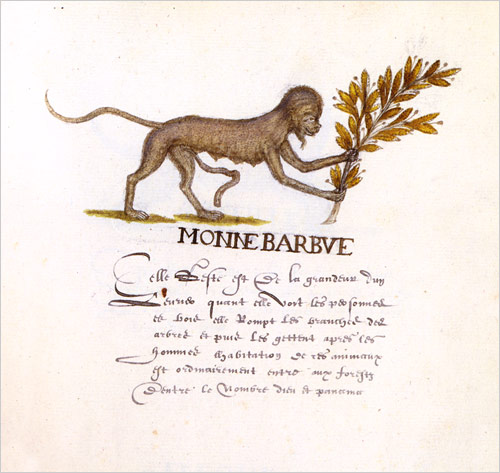
MONNE BARBVE
(Bearded Mona)
“This animal is the size of a greyhound. When it sees people in the woods it breaks off branches and throws them at them…”

MOVQITES
(Mosquito)
“These are small flies which are so small one cannot see them, they are very dangerous. When there is no wind and the weather is calm, they come in droves attacking people, stinging them in such a manner that one would take them for lepers…”

HINDIANE
(Woman of the Indies)
“This woman chases the flies away with a little bell hanging from a tree branch, afraid that when they bite their children, they will cry, for seeing their children cry makes them sad, having visions that at that time the devil is in their body…”

MENSENILLE
(Manchineel Tree)
“A very piusonous tree, so that if a person looks up to it, he will be blinded for three hours afterwards. The Indians hide their arrows in this tree when they are at war in order to make them poisonous.”

CENT PIERNE
(Centipede)
“A very poisonous beast. It feeds in places where there is wine and vinegar. It only moves around at night. A person who has been bitten by this animal lives only for twenty-four hours afterwards. It finds the Indians in their beds in order to kill them.”

TIGRE FERMILLIERE
(Tiger and Anteater)
“Savage beast. However, whenever this small animal called anteater encounters a tiger looking for prey it turns on its back and throws itself on the tiger’s neck and pierces its throat with its snout and claws and does not release him until he is dead on that spot.”


FEU
(Island called “Fougue” or Fire Island)
“During the day one always sees smoke on top and when the sun has set and night has come, one likewise sees a great fiery blaze because on the island and on the summit, the earth produces sulfur and there is thunder and lightening which cause the continuous fire…”

HINDE DE LA TRENITE
(Indian of Trinidad)
“Tha manner of catching parrots is this: if they are large, they make a trap with string attached to it. In this trap they put a parrot with his feet tied and next to him a small animal called a catille which plucks him. When the parrot cries and the other parrots, hearing his voice, come to his rescue, freely joining him in the trap, the Indian seeing this pulls the string and the parrots are instantly trapped.”

PIOVCHE DE MER
“This is as valuable as a louse.”

CIFRE
(Monkey)
“This is a very agile beast. The Indians cannot tame it or feed it for they die of grief and do not eat in captivity. They have a face like a human and are very mischievous and rebellious and throw themselves against people mainly in their faces and eyes.”

PERIQITE LEGERE
(Sloth)
“The nature of this animal is so to climb with its belly uppermost and, climbing this way, it moves faster than a man could on foot. The skin of this animal is very excellent for people suffering from falling sickness [epilepsy]. The head of the afflicted is covered with it then one realizes how effective the skin is.”

HINDES DE IHONA
(Indiands of Ihona)
“When the Indians have defeated their enemies, they make them lie down on the ground, then pound on them, and after that, give them a blow on the head with their sword. When the blood starts flowing, they hold it back promptly, thinking that by this means the body will make a better roast for a solemn feast, calling this a deed of prowess.”

PORC DE MONTENNE
(Mountain Pig)
“This animal is called a mountain pig because it lives in the mountains. It is adroit at climbing. It has a navel on its back. “


AVILANNES BLANCHES GOMITES
(White Physic Nut)
“They may well be called white nuts… They don’t make one vomit at all.” This is as opposed to the black Physic Nut which has quite different effects. “When a person has eaten them, he will throw out everything in his body above and below.” The Indians evidently ate the black nuts when they felt they’d been poisoned as a way of expelling the poison from the mouth and from “below.”

TIBERON
(Shark)
“This fish is very viscious in the sea so that when a sailor throws himself into the water for some reason this fish turns on his back and tears out a leg or an arm and eats it.”
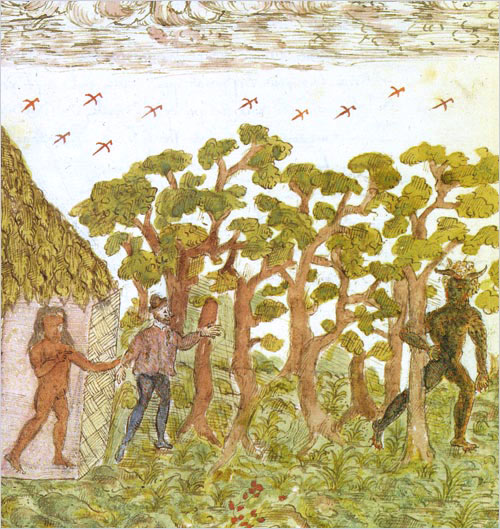
COMES LES YNDIENS ONT ORDINAIRM[ENT] DES JLLUSIONS DU MALING ESPRIT
(How the Indians Usually Have Visions of the Evil Spirit)
“The Indians are much tormented at night by visions of the Evil Spirit whom they call in their language “Athoua.” They do not dare leave their houses at night–only when light has come–and this is because they have no belief nor education and do not worship anything…”
I find these fascinating, and believe me when I say I had trouble choosing from the 199 plates reproduced in the excellent facsimile.
Concerning the images themselves it amazes me to look at them in the artistic context of their time, because though I undoubtedly find them beautiful, when I remind myself that they were created in the 1590’s, and that at that same moment El Greco, Rubens, and Caravaggio were all active… well it’s surprising. Thought of in those terms it’s a wonder these weren’t made by the “Indians” themselves.
I think today, with television and advertising and graphic design having made the shared “visual language” so pervasive, we have a tendency to regard varying levels of visual sophistication simply as styles which homogeneously blanket entire eras, permeating everything from high art to life’s daily banalities. It may be true, to some degree, as far back as the 19th century, but images like those in the Drake Manuscript are, for me, a useful reminder that if you travel further back, our conceptions begin to break down and become little more than assumptions, based on the retrofitted categorizations art historians have coined for us.
The captions fascinate and amuse me for a similar reason. There is something comical to me about contemporaries of Shakespeare, Giordano Bruno, Cervantes, and Galileo ⊕ traveling to these “savage” lands, filled with a blustery and inalienable sense of their own superiority over the ignorant inhabitants, who upon arrival and lengthy inspection proceed to relay information as goofy and superstitious and folkloric ⊕ as their dark-age ancestors might have believed.
Of course, as not to fall into the same trap of egoistic presumption, and lest snide ephemera hunters of the 3000’s stumble upon this blog (attributing it, of course, to Markos Moulitsas or Xeni Jardin whilst my anonymous bones decay in quietude) and scoff at the wrong-mindedness of it all, I’ll shut my mouth right there.
-
For a bit more on the manuscript see-
Histoire naturelle des Indes on Google books.
This pdf from the National Humanities Center.
-
I’ll only say this in closing, I enjoyed these and I hope you did as well.
hide full text

Mechanismo
Or: praise of futures past
A few weeks ago I picked up a book in the bargain bin at Strand titled Mechanismo. When the guy ringing me up at the checkout counter came upon it in my stack, he stopped, flipped through it quickly and somewhat sheepishly, and alerted a buddy standing a few registers down. They admired it together. I remember thinking, “Well, guess that one is Nonist worthy.” ⊕ The book, published in 1978, is essentially a collection of essays by the venerable Harry Harrison on all things science-fictional. What makes the book standout, however, is the bounty of 70’s era sci-fi illustrations contained within, and it’s some of these that I’d like to share with you.


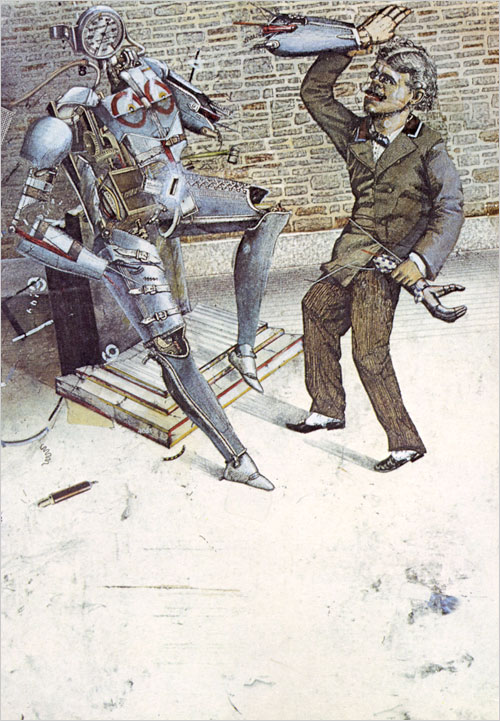
The Dynamometer, originally created by Alfred Jarry in his novel Supermale, as envisioned by artist Russel Mills.



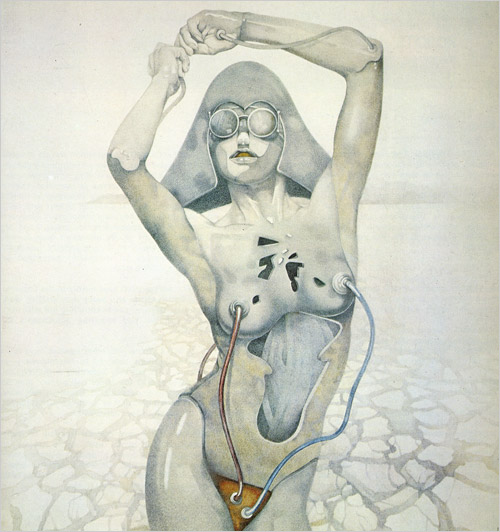

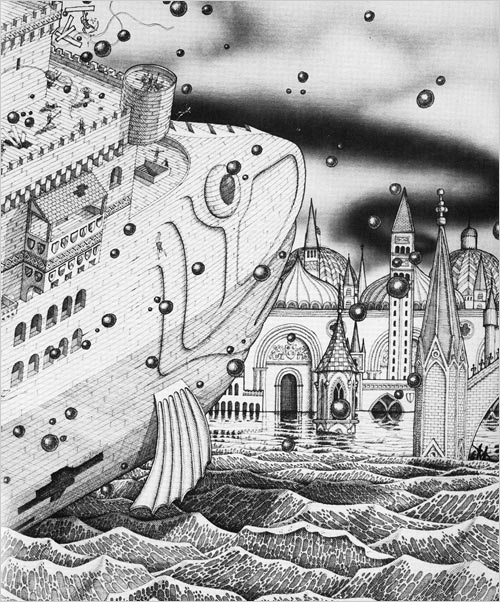
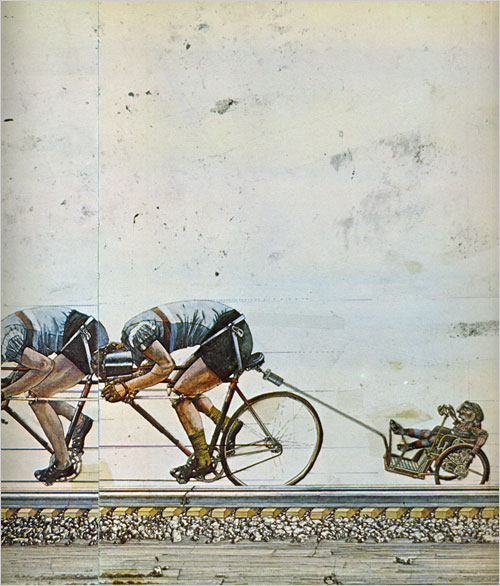
And let’s not forget that enigmatic architectural face, or “Cybertectural Animot,” which began the post. It is a detail of a piece depicting walking cities by artist Mike Wilkes, and you can click here to see the full image.
-
You might look at these images of the future and find them stylistically dated, and they are 30 years old at this point, literally images of futures past, so I wouldn’t argue with you. I do think, however, that in a very palpable way these images, and images like them from the late 50’s all the way through the early 80’s, represent something which, in sci-fi’s drive toward the future, and possibly more to the point its drive toward “respectability,” the marketers of the genre have let slip away. That thing being Style.
A critique of the current face of science fiction and fantasy, as embodied in its book covers, is a voyage I plan to undertake, enthusiastically, in a future post. So I’ll just leave it at that for now.
In the meantime I hope you enjoyed these at least as much as those Strand cashiers seemed to, and I hope the sensation of feeling nostalgia for decades old visions of the future which have not nor may ever arrive is not to off-putting. Likewise I hope deeper reflection on the oddity of such a feeling does not leave any ugly bruises on your brain.
Until next time…
hide full text


In 1846 Dr. Andrew Comstock, proprietor of one of the oldest commercial language schools in America, called Dr. Comstock’s Vocal Gymnasium and Polyglot Institute, published his Treatise on Phonology. In 2008 I came across it on google books and, reading its simultaneously bitchy and braggadocios full title– A Treatise on Phonology: Comprising a Prefect Alphabet for the English Language; a Specimen Exhibition of the Absurdities of Our Present System of Orthography, I laughed. Reason enough to whip-up a quick post, so far as I’m concerned.
Well, as you might expect, it turns out that the “perfect alphabet” of the title, which the book sets forth as remedy to the “absurdities” of English, also mentioned in the title, is a phonetic alphabet created by Comstock himself.
Quote: “It is generally admitted that our orthography is more complicated than that of any other language. Various attempts have been made by different individuals to simplify it. The author of this treatise, however, proposes not only to simplify it, but to perfect it.”
Before you go off half-cocked mocking and scoffing Dr. Comstock for pomposity, first remind yourself that he invented his more-perfect-than-English alphabet at a time when religious and philosophical outlooks on causality were giving way to scientific ones, which is to say that the prevailing feeling among the educated was that with some properly focussed brain-power any “problem” could be “solved” by scientific means, that this was the age of the elocution movement, and that there had already been, before he ever set overconfident pen to paper, at least a century’s worth of individual efforts to overhaul English. Benjamin Franklin had made his own attempt as early as the 1760’s after all, and you wouldn’t mock old Ben now would you?
Then there is the little matter which, being so far removed from grammar school, you have likely forgotten- English is a weird and knotty frankensteinian creature.
(After many paragraphs to back up the statement) Comstock puts it this way: “Our language is hedged about with difficulties which can hardly be overcome even by years of laborious study. The young student is obliged to waste much precious time in learning to spell and read our crooked words, and the adult foreigner is appalled by obstacles which seem to be insurmountable. Now, all these difficulties would be entirely removed by the adoption of a perfect alphabet — an alphabet which should represent language phonetically.”
Of course, now that you’ve reminded yourself of these things, you can go ahead and laugh anyway.
I personally find myself amused, not so much by the seemingly quixotic quest to just put on the brakes and change the course of a living language, but by the obvious galled irritation Dr. Comstock felt.
Quote: “...the 38 elementary sounds of the English language are represented in 336 different ways, which may be considered equivalent to three hundred and thirty-six different letters! Is it possible to conceive of a more complicated, absurd, unphilosophical, and barbarous system of orthography?”
Barbarous?! Hahaha.
We, all of us, find aspects of our own vocations thorny and annoying. The convolutions and abstruseness and wrong-mindedness which seem to permeate every human endeavor formulated or informed by any consciousness other than our own can exasperate; but imagine if your vocation was language! Imagine if it were English itself that stuck in your craw. Talk about fighting windmills.
Anyhow, if you are interested, Comstock’s phonetic alphabet broke down essentially as follows-
Quote: “This Alphabet comprises all the letters of the Phonetio Alphabet for the English Language, with additional ones to represent sounds peculiar to foreign languages. Comstock’s Phonetic Alphabet is the common, or Boman alphabet, not only so extended, by the addition of new letters, that there is a character for every articulate sound, but so improved by the introduction of signs for the various modifications of the voice in speech, that there is a character for every accent, inflection, intonation, etc. Hence it must be considered a perfect alphabet.”
Including all 44 characters and 16 tone marks Comstock’s perfect alphabet looked like this-

If you were enthusiastic about the alphabet and wanted to set about immediately hand-writing a letter to your dear old mother, or your betrothed in Niagara Falls, you could refer to this chart as a guide-

Meanwhile if you wanted to set about teaching the gents down at the club or the fellows at the beer garden this new method, some charts depicting mouth articulations, grouped by phoneme, would be helpful. Luckily Comstock furnished these, saying-
Quote: “An accurate knowledge of the positions which the organs of articulation should assume in the formation of the several elements of vocal language, is very important to those who would speak with ease and elegance. To aid the reader still further in the acquisition of this knowledge, he is furnished with the various postures of the mouth, required in uttering the elements energetically, and singly.”

“The pupil should exercise his organs of speech, in the most forcible manner, every day, on all the elements. The vowels should be exploded from the throat, both interrogatively and affirmatively, in every range of pitch.”
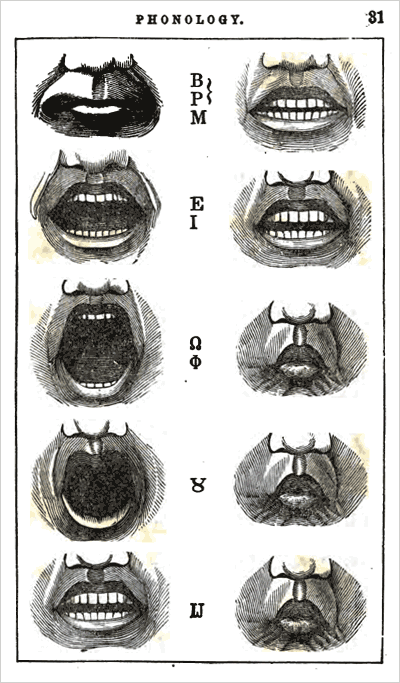
Certainly, even armed with logic and charts and enthusiasm, there would be some doubters. To them, leaving aside stability and ease of use, you could quote a few of the many benefits Comstock himself lists, like, say-
3. It would enable one to spell and read in one-twentieth the time required by the present absurd and barbarous orthography.
4. It would render the teaching and the learning of the English language, which, by the old theory, are extremely irksome, highly interesting.
7. It would interdict provincialisms; because, according to this theory, all words are spelled as they are pronounced, and, consequently, pronounced as they are spelled, every graphic word being a perfect Daguerreotype of the vocal word which it represents.
10. As, in phonetic spelling, most of the words have fewer letters than are employed in our present orthography, this alphabet would enable a writer to put more matter upon the same page.
13. The adoption of this alphabet would not only be the means of greatly advancing the cause of science and literature, but would be invaluable to the missionary in disseminating a knowledge of the gospel among the heathen.
How can you argue with that? Comstock certainly couldn’t see any way.
Quote: “The Author feels confident that no one who peruses this treatise understandingly, will desire to cling any longer to the old system of orthography, unless he prefers chaos to order, —discord to harmony, —darkness to light. Hence, he sends forth his Alphabet to the world with the most sanguine expectation that it will meet the entire approbation of the public, and be speedily adopted.”
I might wonder weather, having seen his countrymen choose chaos, discord, and darkness over his perfect alternative, he died sanguine as well… were it not for the obvious linguistic contradiction of it.
Anyhow, hindsight being smug and sadistic as it is, we know his grandiloquent claims and aims came to naught. We know also that the scores of other contrived alphabets which came before and after his met similar fates. I don’t believe there has ever been a constructed script, in the history of the world, which has supplanted a “naturally” evolved predecessor by dint of logic and force of will.
Perhaps it’s the fact that, as in Comstock’s case, a switch might benefit 3rd graders and immigrants but would effectively render the entire adult population of the country illiterate in the bargain?
Perhaps it’s because, ever since learning as ankle-biters what the characters MOMMY added up to, our alphabet is so intertwined with our language, and hence, our thoughts, our minds, our being, that we would never and could never willingly replace it?
Perhaps it’s because language is a vibrant and living and evolving thing which has never, not even in or present “barbarous” orthography, been truly tamed and finally codified?
Or perhaps it’s just that the overwhelming majority of us are not elocution teachers, or linguists, or grammarians, and so the quirks of English just simply do not stick in our craws enough to warrant, in any of our minds, a “solution?”
Hell, I don’t know.
Though his perfect alphabet is all but forgotten, I would like to thank Dr. Comstock, none the less, for not only affording me a chuckle (which I suppose I ought to be offering apologies for rather than thanks) but more importantly for occasioning circumstances in which the letters “Phonemenon” could be put together, in that exact order, and be something other than a misspelling.
So in his honor, finally, let me offer the following, may it live on in the minds and mouths of we who have choosen chaos, discord, and darkness:
Pho·nem·e·non [fo-neem-uh-non]
noun. plural: phonemena.
1. A vocalization, or sound made with the mouth, that is perceptible by the senses.
2. A remarkable or outstanding utterance.
Hope you enjoyed.
hide full text



